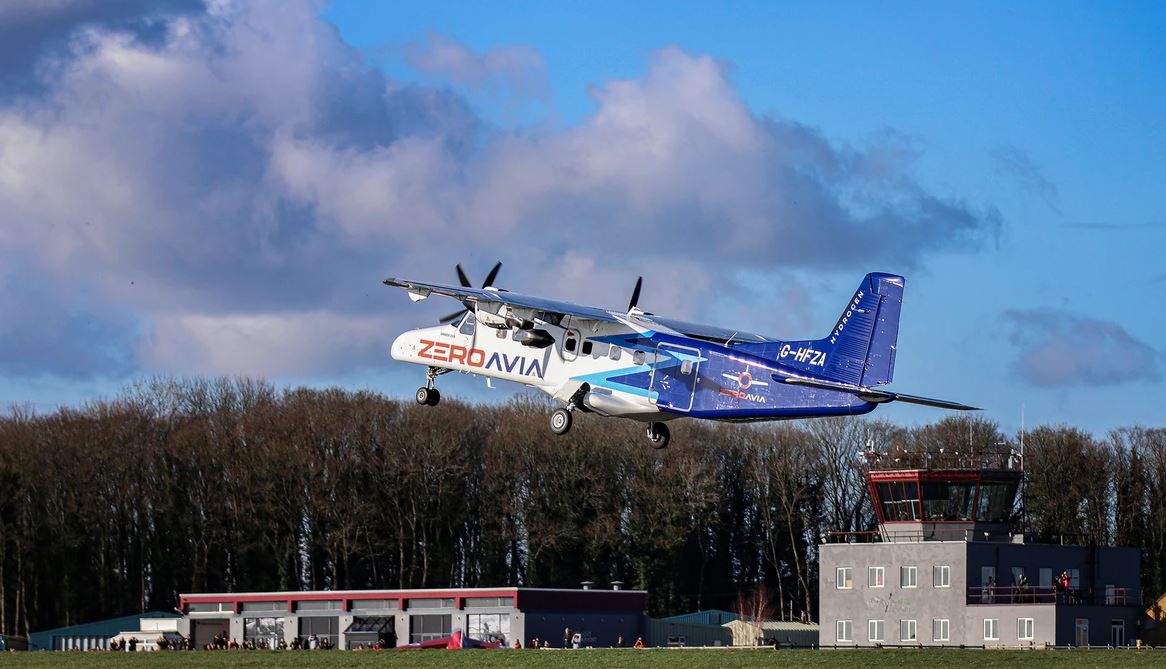ZeroAvia conducted a 10-minute test flight this week for what it claims is the world's largest aircraft to be powered by a hydrogen-electric engine. The UK company's 19-seat Dornier 228 testbed aircraft is retrofitted with a full-size prototype hydrogen-electric powertrain on the left wing. “This is the largest ZeroAvia engine tested to date, and places the company on the direct path to a certifiable configuration to be finalized and submitted for certification in 2023,” it said. The aircraft has a 600 kW powertrain twin-engine on its left wing and a single Honeywell TPE-331 stock engine on the right. “The hydrogen-electric powertrain comprises two fuel cell stacks, with lithium-ion battery packs providing peak power support during take-off and adding additional redundancy for safe testing,” the company said, noting that the hydrogen tanks and fuel cell power generation systems were embedded in the cabin.
Chinese researchers has reported a superaerophilic/superaerophobic cooperative electrode that can promote bubble removal in electrolyzers. The Chinese Academy of Sciences and Beihang University researchers introduced titanium-based superaerophilic (SAL) stripes covered with gas cushions on the platinum-based electrode. Superaerophobic (SAB) electrocatalytic regions surrounded the SAL stripes. The stripes acted as gas channels to transport hydrogen out. They noted that bubble adhesion on the electrode, bubble dispersion in the vicinity of the electrode, and poor dissolved hydrogen diffusion are common problems in electrolysis. “Benefiting from the enhanced mass transfer, the overpotential for the SAL/SAB cooperative electrode at −10 mA cm−2 is only −19 mV, compared to −61 mV on the flat Pt electrode,” they wrote in Science Advances.
Egypt-Japan University of Science and Technology researchers have found that hydrogen production systems based on waste heat systems at 22.91% offer the highest overall efficiency. System efficiency ranges from 11.6% to 22.91%, while the levelized cost of hydrogen (LCOH) ranges from $1.19/kg to $12.16/kg, the researchers said. “The lowest value is obtained when waste heat is employed, followed by the grid, PV panels, and wind turbines. Wind turbine systems are not recommended at selling prices of $8/kg and $10/kg,” they wrote in a recent article in Energy Conversion and Management.
Centrica Business Solutions is working with Germany’s 2G Energy to provide customers with 100% hydrogen-ready combined and heat power (CHP) systems in the United Kingdom, Ireland, the Netherlands, and Italy. “With a return on investment of less than 12 months for some projects, hydrogen ready CHP remains an energy saving quick-win,” said the England-based company.
Fusion Fuel has signed an offtake agreement with Portuguese natural gas utility Dourogás for green hydrogen from its projects in Portugal. “This represents Fusion Fuel’s first offtake contract aimed at blending green hydrogen within the Portuguese natural gas grid,” said the Irish company. The Evora facility will likely be commissioned this year. The facility is expected to produce roughly 40 tons of green hydrogen per year.
Hydrogène de France (HDF Energy) has signed a memorandum of understanding with the province of Kinshasa, Congo, to construct and operate a green hydrogen solar plant. “This is the first project of its kind planned in Central Africa,” claimed HDF Energy. It said it is considering a location in the southern part of the country.
This content is protected by copyright and may not be reused. If you want to cooperate with us and would like to reuse some of our content, please contact: editors@pv-magazine.com.



By submitting this form you agree to pv magazine using your data for the purposes of publishing your comment.
Your personal data will only be disclosed or otherwise transmitted to third parties for the purposes of spam filtering or if this is necessary for technical maintenance of the website. Any other transfer to third parties will not take place unless this is justified on the basis of applicable data protection regulations or if pv magazine is legally obliged to do so.
You may revoke this consent at any time with effect for the future, in which case your personal data will be deleted immediately. Otherwise, your data will be deleted if pv magazine has processed your request or the purpose of data storage is fulfilled.
Further information on data privacy can be found in our Data Protection Policy.